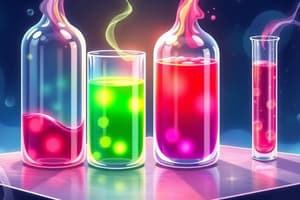Podcast
Questions and Answers
Acids are generally bitter in taste.
Acids are generally bitter in taste.
False (B)
What happens to blue litmus paper when it is dipped into an acid?
What happens to blue litmus paper when it is dipped into an acid?
- It turns green
- It remains blue
- It dissolves
- It turns red (correct)
What common household item is an example of a base?
What common household item is an example of a base?
Sodium bicarbonate
Acids liberate __________ when they react with some metals.
Acids liberate __________ when they react with some metals.
Which statement accurately describes the relationship between acids and the terms derived from Latin words?
Which statement accurately describes the relationship between acids and the terms derived from Latin words?
Match the following substances with their category:
Match the following substances with their category:
Which property is NOT characteristic of bases?
Which property is NOT characteristic of bases?
What happens to the electrostatic forces between ions when sodium chloride is dissolved in water?
What happens to the electrostatic forces between ions when sodium chloride is dissolved in water?
Which of the following correctly identifies a Lewis acid?
Which of the following correctly identifies a Lewis acid?
What type of reaction occurs between an acid and a base to produce salt?
What type of reaction occurs between an acid and a base to produce salt?
Identify the incorrect statement about salts.
Identify the incorrect statement about salts.
What taste is commonly associated with acidic substances?
What taste is commonly associated with acidic substances?
Which compound is an example of a weak acid commonly found in food?
Which compound is an example of a weak acid commonly found in food?
Which of the following is NOT a function of water as a solvent?
Which of the following is NOT a function of water as a solvent?
What is the effect of a base on blue litmus paper?
What is the effect of a base on blue litmus paper?
Flashcards are hidden until you start studying
Study Notes
Acids
- Acids exhibit the property of acidity and are characterized by their sour taste.
- Common acids include hydrochloric acid, citric acid (found in lemons and oranges), ascorbic acid (vitamin C), and tartaric acid (found in tamarind).
- The term "acid" originates from the Latin word "acidus," meaning sour.
- Dipping blue litmus paper in acid results in a red coloration, while red litmus paper remains unchanged.
- Acids can release dihydrogen when reacting with certain metals.
Bases
- Bases turn red litmus paper blue, and blue litmus paper remains unchanged.
- They are known for their bitter taste and a soapy feel.
- Common bases include sodium bicarbonate (baking soda) and household bleach.
Salts
- Salts are formed from the reaction between an acid and a base, with sodium chloride as a primary example.
- Sodium chloride (common salt) is produced from the reaction of hydrochloric acid with sodium hydroxide.
- It consists of positively charged sodium ions and negatively charged chloride ions, which are held together by electrostatic forces.
- Electrostatic forces are inversely proportional to the dielectric constant of the medium in which they exist.
- Water, as a universal solvent, has a dielectric constant of 80, which reduces electrostatic forces and allows ions to move freely when sodium chloride is dissolved.
- Hydration of ions with water molecules enhances their separation in solution.
Lewis Acids and Bases
- The silver cation (Ag⁺) acts as a Lewis acid due to its ability to accept electron pairs.
- Ammonia (NH₃) functions as a Lewis base because it can donate an electron pair.
Acids
- Acids exhibit the property of acidity and are characterized by their sour taste.
- Common acids include hydrochloric acid, citric acid (found in lemons and oranges), ascorbic acid (vitamin C), and tartaric acid (found in tamarind).
- The term "acid" originates from the Latin word "acidus," meaning sour.
- Dipping blue litmus paper in acid results in a red coloration, while red litmus paper remains unchanged.
- Acids can release dihydrogen when reacting with certain metals.
Bases
- Bases turn red litmus paper blue, and blue litmus paper remains unchanged.
- They are known for their bitter taste and a soapy feel.
- Common bases include sodium bicarbonate (baking soda) and household bleach.
Salts
- Salts are formed from the reaction between an acid and a base, with sodium chloride as a primary example.
- Sodium chloride (common salt) is produced from the reaction of hydrochloric acid with sodium hydroxide.
- It consists of positively charged sodium ions and negatively charged chloride ions, which are held together by electrostatic forces.
- Electrostatic forces are inversely proportional to the dielectric constant of the medium in which they exist.
- Water, as a universal solvent, has a dielectric constant of 80, which reduces electrostatic forces and allows ions to move freely when sodium chloride is dissolved.
- Hydration of ions with water molecules enhances their separation in solution.
Lewis Acids and Bases
- The silver cation (Ag⁺) acts as a Lewis acid due to its ability to accept electron pairs.
- Ammonia (NH₃) functions as a Lewis base because it can donate an electron pair.
Studying That Suits You
Use AI to generate personalized quizzes and flashcards to suit your learning preferences.



